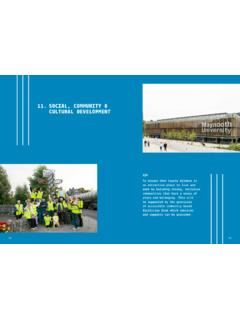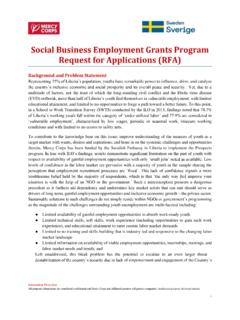Transcription of Literature Review on the Impact of Digital …
1 CHILDREN, EDUCATION AND SKILLS researchsocialLiterature Review on theImpact of Digital Technologyon learning and teaching Literature Review on the Impact of Digital technology on learning and teaching ICF Consulting Services Ltd November 2015 Table of Contents Executive Summary .. 1 1: 5 Context .. 5 Aims and objectives of this study .. 6 Structure of the report .. 6 2: Method .. 7 Results of the Literature search .. 7 The quality of the Literature .. 9 3: Digital learning and raising attainment .. 12 Raising children s attainment.
2 13 Literacy .. 15 Numeracy .. 18 Science learning .. 21 Ingredients of success .. 23 4: Digital learning , reducing inequalities and promoting inclusion .. 25 Reducing inequalities between learners .. 25 Ingredients for success .. 27 5: Digital learning and improving transitions into employment .. 28 Improving children s transition between education and work .. 28 Ingredients for success .. 30 6: Digital learning and enhancing parental engagement .. 31 Improving engagement .. 31 Ingredients for success .. 33 7: Digital learning and improving the efficiency of the education system.
3 34 Improving teacher and school efficiency .. 34 8: Conditions to bring about effective use and integration of Digital 37 Overcoming resistance to changes in teaching approaches .. 38 Networking/team working .. 39 Provision and maintenance of equipment .. 40 9: Conclusions .. 41 Impacts on learning and teaching .. 41 Successful implementation .. 43 Annex 1: Research protocol .. 45 The inclusion criteria .. 45 Search strategy .. 46 Scope of the Literature Review : definitions .. 48 Annex 2: Assessment framework.
4 49 Annex 3: Bibliography .. 52 Annex 4: Meta-analysis Literature reviews included in the Review .. 55 1 Executive Summary This Literature Review was commissioned by the Scottish Government to explore how the use of Digital technology for learning and teaching can support teachers, parents, children and young people in improving outcomes and achieving our ambitions for education in Scotland. Approach This study is designed to help inform the development of a strategy for Digital learning and teaching by providing evidence of how and why Digital learning and teaching can benefit learners, teachers and schools.
5 It also aims to identify the conditions that lead to its successful implementation and any differences between primary and secondary settings. In particular it focuses on how Digital technologies can support and contribute to five specific educational priorities: raising attainment, tackling inequalities and promoting inclusion, improving transitions into employment, enhancing parental engagement, and improving the efficiency of the education system. A Literature search was undertaken, collecting nearly 1,000 items from academic, governmental and professional sources.
6 These were reviewed to determine their thematic relevance and the strength of the evidence they presented. The most useful were then collated and assessed to: Identify evidence of relationships between Digital learning and teaching activities and the expected outputs, outcomes and impacts; Show the relationships that exist between the Digital learning and teaching activities and the outputs, outcomes and impacts for different beneficiaries (learners, parents, teachers, and the school); and Identify which outcomes are immediate, medium-term and long-term.
7 Key findings The key findings of the research are presented below, separated into the key thematic areas which were examined during the Review . In the cases where studies of similar Digital equipment, tools and resources have been systematically reviewed or where there is a large body of evidence from different studies which have measured change (from quantitative studies using counterfactuals and testing learners before and after), it is possible to state there is conclusive evidence. In other cases where the evidence base is weaker (mainly qualitative studies drawing on relatively small samples of learners and schools), it is only possible to state that there is indicative evidence or (where few cases) promising evidence.
8 2 Raising children and young people s attainment There is conclusive evidence that Digital equipment, tools and resources can, where effectively used, raise the speed and depth of learning in science and mathematics for primary and secondary age learners. There is indicative evidence that the same can be said for some aspects of literacy, especially writing and comprehension. Digital technologies appear to be appropriate means to improve basic literacy and numeracy skills, especially in primary settings. The level of Impact is generally similar to other changes to pedagogies which are effective in raising attainment although the use of Digital learning has other benefits.
9 Additionally, the extent of the effect may be influenced by the level of capability of teachers to use Digital learning tools and resources effectively to achieve improved learning outcomes. More effective use of Digital teaching to raise attainment happens when teachers are able to identify how Digital tools and resources can be used to achieve improved learning outcomes, as well as having knowledge and understanding of the technology . This applies in all schools. Where learners use Digital learning at home as well as school for formal and non-formal learning activities these have positive effects on their attainment.
10 This is due to the extension of their learning time. This is particularly important for secondary age learners. Reducing inequalities and promoting inclusion There is indicative evidence that the use of Digital tools and resources can help to reduce gaps in subject attainment when they are effectively implemented. There is promising evidence that the use of Digital equipment and resources can help learners with additional support needs to improve their skills and competences in literacy and numeracy. Teachers skills and competences in recognising how to use Digital tools and resources and applying them effectively are critical to achieving positive results for learners with additional support needs or who are disdvantaged in other ways.














